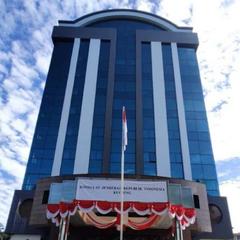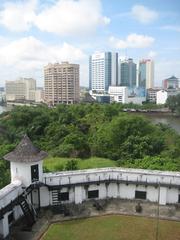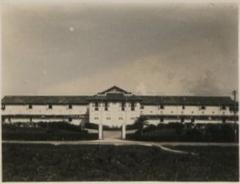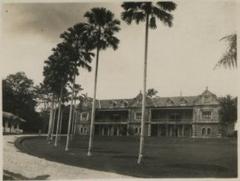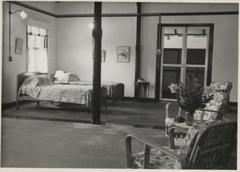
Kuching Old Courthouse: Visiting Hours, Tickets, and Historical Guide
Date: 04/07/2025
Introduction
The Kuching Old Courthouse, majestically situated along the Sarawak River in downtown Kuching, Malaysia, is a defining emblem of Sarawak’s colonial and multicultural heritage. Originally constructed in the late 19th century, this well-preserved landmark has transitioned from an administrative and judicial center under the Brooke dynasty to a vibrant cultural hub. Today, it welcomes visitors eager to explore Sarawak’s layered history, distinctive architecture, and dynamic contemporary culture.
This detailed guide provides you with everything you need to make the most of your visit: a historical overview, architectural highlights, practical information on Kuching Old Courthouse visiting hours and tickets, accessibility notes, directions, and tips for nearby attractions. For up-to-date insights and special events, consult resources like the Sarawak Tourism Board and local heritage organizations (Kuching Court Building Brief History; Sarawak Tourism Board; Secret Attractions).
Table of Contents
- Historical Overview
- Visitor Information
- Frequently Asked Questions (FAQ)
- Preservation and Adaptive Reuse
- Visitor Tips
- Conclusion
- References and Further Reading
Historical Overview
The Brooke Era and Early Courthouse
The story of the Kuching Old Courthouse begins in the mid-19th century, closely tied to the reign of the Brooke dynasty. The original structure was a modest wooden building established in 1847 by Lutheran missionary Rupe, intended for education but quickly repurposed by James Brooke, Sarawak’s first White Rajah, as a courthouse (Kuching Court Building Brief History). Early court sessions took place at what is now the Astana Negeri before moving to this wooden courthouse, which also temporarily hosted Dr. Francis Thomas McDougall, Borneo’s first bishop.
Reconstruction and Expansion
The courthouse gained historical prominence during the 1857 Bau Chinese insurrection, when rebel leader Liu Shanbang briefly captured and occupied it. This episode underscored the site’s strategic importance and led to the eventual demolition of the original wooden building in 1858. Charles Brooke, ascending as the Second Rajah in 1868, commissioned a new courthouse, consolidating colonial governance and judicial functions. Construction spanned seven years, culminating in its official opening in 1874 (Kuching Court Building Brief History).
Architectural Features
The Kuching Old Courthouse exemplifies British colonial architecture, harmoniously blended with local Bornean influences. The complex consists of four main blocks arranged around an open courtyard, facilitating natural ventilation and light—an adaptation for tropical Sarawak. Notable features include:
- Massive Tapered Columns: Lining the corridors, they provide both grandeur and shade.
- Clock Tower (1883): A signature landmark with twin supporting columns.
- Dayak Motif Ceiling: Intricately carved by Baram artisans in 1951, reflecting indigenous artistry.
- Balcony Railings: Decorated with Romanesque carvings, adding an eclectic flair.
Surrounding government offices—such as the Treasury, Post Office, and Surveyor’s Office—underscored the courthouse’s role as Kuching’s administrative nucleus.
Wartime and Civic Legacy
The courthouse expanded over decades, with additions like the “Japanese Building” during World War II and the 1886 “Round Tower,” which served as a fort, dispensary, and later a registry office. During Japanese occupation, the site was commandeered for military use. For almost a century, it was the seat of the General Council (later Council Negeri), Sarawak’s legislative body, and later the High Court of Borneo.
Modern Role and Memorials
Since the 1970s, the Old Courthouse has transitioned to a cultural complex, housing galleries, shops, and cafes while preserving heritage features. The Charles Brooke Memorial obelisk, unveiled in 1924, stands near the riverfront, honoring the Second Rajah’s contributions (Kuching Court Building Brief History).
Visitor Information
Kuching Old Courthouse Visiting Hours
- General Opening Hours: Daily, 9:00 am – 4:45 pm (last entry at 4:15 pm).
- Public Holidays/Special Events: Hours may vary; check with the Sarawak Tourism Board or the visitor information center for updates.
Tickets and Admission
- Admission: Entry to the courthouse complex is typically free.
- Special Exhibitions: The Ranee Museum and select exhibitions may charge a small fee (usually RM5 for adults, RM2 for children; prices may change). Confirm prices onsite or via official channels.
Accessibility
- Wheelchair Access: Ramps and wide entrances are available; most areas are accessible, though some historic staircases may pose challenges.
- Restrooms: Clean and accessible facilities are provided.
- Family-Friendly: Open spaces and interactive exhibits cater to families and school groups.
Getting There
- Location: Main Bazaar Road, adjacent to the Kuching Waterfront, centrally located in Kuching’s historic district.
- On Foot: Walkable from most city hotels and major attractions.
- By Car: Limited parking nearby; ride-hailing services like Grab are widely available (WanderwithJo).
- Public Transport: Stops for city buses are within a short walk.
Guided Tours and Events
- Guided Tours: Available through the Sarawak Tourism Complex; highly recommended for in-depth historical context. Tours last 45–60 minutes.
- Cultural Events: The complex regularly hosts art exhibitions, performances, and community gatherings; check event calendars onsite and online (Amazing Borneo).
Photography and Facilities
- Photography: Allowed throughout the complex, except where indicated (such as inside certain museum exhibits).
- Facilities: Café, bar, gift shop, free Wi-Fi in public areas, and a tranquil central courtyard.
Nearby Attractions
- Kuching Waterfront
- Sarawak Museum
- India Street & Chinatown
- Fort Margherita
- Heritage Walking and Kampong Bike Tours
These sites, all within walking distance, together provide a multifaceted experience of Kuching’s history and culture (Secret Attractions; The Crazy Tourist).
Frequently Asked Questions (FAQ)
Q: What are the Kuching Old Courthouse visiting hours?
A: Open daily, 9:00 am – 4:45 pm (last entry at 4:15 pm). Hours may vary on holidays.
Q: Is there an entry fee?
A: Admission is free; some exhibitions have a small ticket fee.
Q: Is the courthouse wheelchair accessible?
A: Yes, ramps and accessible restrooms are provided, though some older staircases may be challenging.
Q: Are guided tours available?
A: Yes, tours are available and recommended for historical context.
Q: Can I take photos inside?
A: Photography is permitted except in some museum areas where restrictions apply.
Q: What are the best times to visit?
A: Early mornings or late afternoons are ideal for cooler temperatures and softer light for photography.
Preservation and Adaptive Reuse
The Kuching Old Courthouse is a model of heritage preservation in Malaysia. After ceasing its judicial role in the early 2000s, the site underwent careful restoration guided by international standards. It now operates as the Sarawak Tourism Complex, with adaptive reuse ensuring the protection of its architectural integrity while offering new functions as galleries, cafes, and event venues (facts.net).
Visitor Tips
- Dress Comfortably: Light, modest clothing is recommended due to Kuching’s hot, humid climate.
- Weather Precautions: Bring an umbrella or raincoat, especially during the wet season (November–February).
- Event Planning: Check official websites or onsite boards for current exhibitions and performances.
- Combine Visits: Consider pairing your trip with a stroll along the Kuching Waterfront or a visit to Fort Margherita for a full heritage experience (Travelynn Family).
Conclusion
The Kuching Old Courthouse stands as a living testament to Sarawak’s colonial legacy and multicultural evolution. Beyond its striking architecture and historical memorabilia, it offers a vibrant cultural experience through exhibitions, performances, and community events. With free or affordable admission, accessible facilities, and a central location, it is an essential stop for anyone seeking to understand Kuching’s rich heritage.
Enhance your visit by utilizing guided tours, checking event calendars, and exploring the nearby attractions that make Kuching a premier heritage destination in Malaysia. For the latest updates and visitor tips, download the Audiala app and follow official tourism channels (Kuching Court Building Brief History; Sarawak Tourism Board; Secret Attractions; The Crazy Tourist).
References and Further Reading
- Kuching Court Building Brief History
- Sarawak Tourism Board
- Secret Attractions: Hidden Cultural Spots in Kuching
- The Crazy Tourist: 25 Best Things to Do in Kuching, Malaysia
- Travelynn Family: Kuching with Kids
- WanderwithJo: Things to Do in Kuching
- Amazing Borneo: Must-Visit Cultural Attractions in Kuching
- Wanderlog: The Old Court House Kuching

